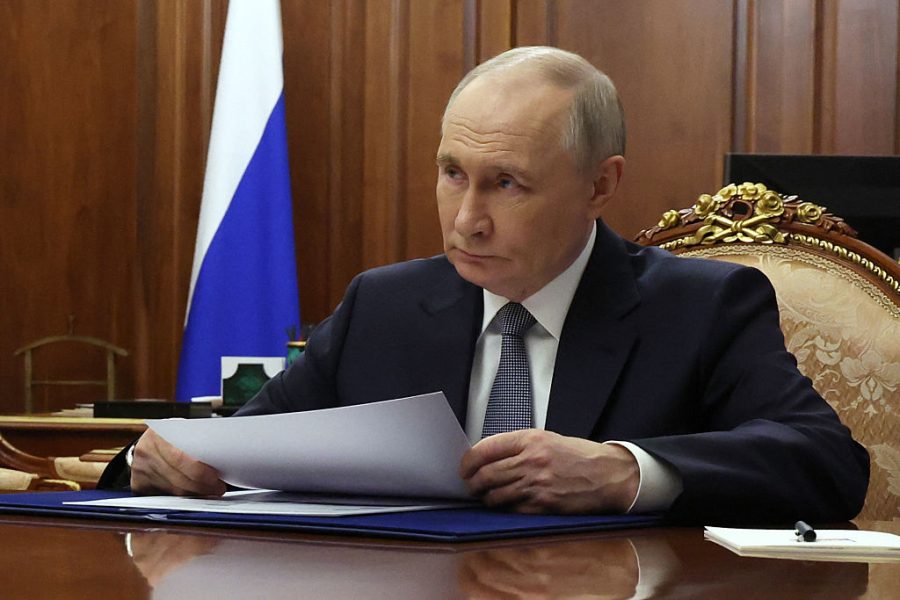When Donald Trump unveiled his table of tariffs in Washington last week, there was one country that was conspicuously absent from his list: Russia. The White House’s argument was that there was no point slapping tariffs on trade with Moscow because the existing sanctions in place against it meant there was negligible bilateral trade going on between the two countries. Despite this, the global trade war that has erupted will still impact Russia, threatening to undermine Moscow’s economic stability, stifle its already slowing growth and amplify its strategic dependence on Beijing.
Trump’s trade realignments will further marginalise Russia as an energy supplier
The White House’s justification for excluding Russia from its tariffs list withers under scrutiny. In 2024, Russian exports to the US totalled $3.27 billion (£2.56 billion) – a three-decade nadir – with American exports to Russia at a mere $526 million (£412 billion). By comparison, Lesotho – an African nation with just two million inhabitants – exports approximately $2 billion (£1.6 billion) to America annually, yet still managed to incur a punitive 50 per cent tariff.
Applying Trump’s method for how he calculated the tariffs he is imposing to current Russian trade figures would have warranted a 40 per cent levy on Moscow’s goods. This is just a notch higher than the 35 per cent levy, imposed on Russia in 2022 as a punishment for its invasion of Ukraine. Based on pre-war 2021 trade patterns, Russia, whose exports to the US roughly equalled its import of American goods, would have faced a 10 per cent tariff.
Russia’s conspicuous exemption from Trump’s list may represent a calculated manoeuvre to leverage influence over President Vladimir Putin during the ongoing, snail-paced Ukraine peace negotiations. But Russia’s export volumes to the US amount to less than 1 per cent of its total and are so insignificant that they are unlikely to influence the Kremlin’s policy, particularly while sanctions remain in force. It is sanctions, not the tariffs, that matter for Russian trade.
Following Trump’s tariff announcement, Russia’s stock market fell along with those of other countries. Thanks to lower export volumes to the US and the absence of international financial investors in Russia, the fall was modest – the Moscow Exchange dropped 8 per cent between Thursday and Monday. The lack of progress in the peace talks and securing sanctions’ relief from America, combined with tanking oil prices, resulted in a 14-day uninterrupted streak of the stock market index declining, the longest in its history.
The Ukraine peace negotiations, now at an impasse, were the main driver of growth in the Russian market at the start of the year. Trump’s trade war has now shunted them down the list of America’s priorities.
Russia’s sanctions-induced superficial insulation from the world’s financial systems hides its vulnerability to the secondary effects of a protracted trade conflict. For Russia, the main source of pain will come from oil. The sudden decline in crude prices poses the most immediate threat. As trade hostilities dampen global growth –particularly in Asia – the demand for Russia’s primary export will falter. Brent crude has already plummeted below $63 (£49) per barrel, while the Russian Urals benchmark is trading at $53 (£41.5) – significantly below the $60 (£47) figure underpinning the Kremlin’s 2025 national budget.
With oil prices tanking and the rouble performing unexpectedly strongly, the Kremlin will be confronted with an expanding fiscal deficit: it will get fewer roubles for every barrel sold, as the barrel price has tanked, and the dollar now also costs less in roubles. The Kremlin might be obliged to borrow more money to cover the widening fiscal deficit. In the middle of a trade war, this won’t be cheap. All of this creates an unenviable trilemma for Vladimir Putin: increase already-unpopular taxation, curtail defence expenditures amid its ongoing war, or reduce social spending at the risk of domestic discontent.
Trump’s trade realignments will also further marginalise Russia as an energy supplier. As countries scramble to reduce their trade imbalances with the US, American oil and LNG will become increasingly attractive alternatives to Russian exports. This will also give Asian buyers leverage to demand steeper discounts on Russian supplies while Moscow’s prospects for re-entering the European energy markets grow increasingly remote.
Declining export revenues and the global economic turmoil may compel Russia’s central bank to maintain elevated interest rates, thereby increasing the cost of borrowing for consumers and businesses. With civilian industrial output almost stagnant, imports declining and inflation eroding purchasing power, Russia faces looming stagflation – a particularly pernicious condition for a sanctioned wartime economy.
As China, in particular, embroils itself in an increasingly hostile trade war with American and the yuan devalues, Russia inevitably becomes both a more attractive market for Beijing’s goods and a more vulnerable partner. This power asymmetry threatens to accelerate Russia’s transformation into Beijing’s junior ally.
Russia’s semi-isolation from global markets has failed to give it adequate protection against global economic contagion. The emerging trade war between America and the world may inflict damage similar to that of existing sanctions. The crucial difference is that, in this case, Moscow might have less state money available to inject into the economy and cushion the blow.







Comments